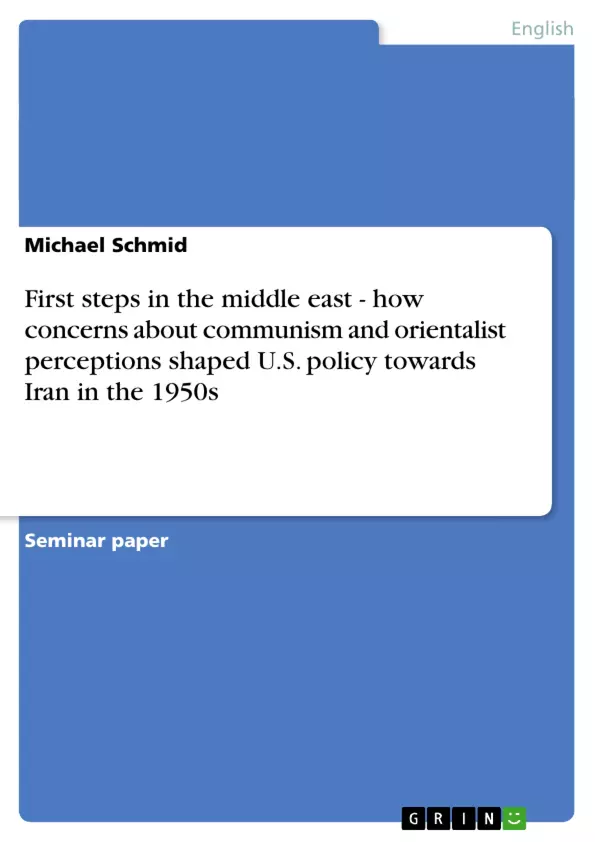No area seems to be of more importance in the field of foreign policy and diplomatic history today than the so called Middle East. The continuing clashes between Israeli forces and Palestinian suicide bombers, the difficult challenge of stabilizing a newly elected government in Iraq and the growing tension between Iran and the international community concerning the issue of nuclear power are just a few examples which illustrate the urgency to look at origins of these conflicts. As an example for this essay, I have chosen the case of Iran. I will focus on the very beginning of the involvement of the United States in the Middle East, and I will demonstrate what kind of issues and perceptions played an essential role in the determination of U.S. policy towards Iran.
Although I do not attempt to find causes for the current situation, some of the factors I will identify in this essay might also serve as an explanation for the current conflict with Iran. Yet, this is not my primary intention and further research and empirical data will be required to investigate connections to the contemporary situation with Iran.
However, I will argue that the way US policymakers viewed their Iranian counterparts did not change fundamentally for many decades at least regarding the country of Iran if not more countries in the Middle East. I downplay this aspect because a lot more research is needed to support this argument and it would extend beyond the scope of this essay. Mostly the dealings with Iran and its premier Muhammad Musaddiq in the early 1950s at the time of the Anglo-Iranian oil crises will be of relevance.
The essence of my argument is that even though strategic thinking and the fear of a communist takeover of Iran played a role in negotiating with Iran, the reason why Musaddiq was toppled by the CIA and the British MI-6 was because Western diplomats had a so called “orientalist” mindset and perceived him as too weak and irrational as to fight off Soviet attacks and propaganda which could have led to an eventual takeover of Iran by Soviet forces. In order to pre-empt that, the United States and Britain collaborated to bring down Musaddiq and install a shah regime that would, on the one hand be more favourable to Western oil interests, and on the other hand more resistant regarding possible Soviet invasion efforts.
Inhaltsverzeichnis (Table of Contents)
- Introduction
- Sources
- The United States, Britain and Iran: An Overview
- Short Biography of Muhammad Musaddiq
- The Concept of Orientalism and American Orientalism
- Perception, Misperception and Orientalism
- The Limits of Misperception
- The Characterization of Musaddiq in recent Literature
- Conclusion
Zielsetzung und Themenschwerpunkte (Objectives and Key Themes)
This essay examines the early stages of U.S. involvement in the Middle East, focusing on the development of U.S. policy towards Iran during the early 1950s. The essay explores the influences that shaped this policy, including concerns about communism and the role of "orientalist" perceptions of Iran and its leaders. While not intended to provide explanations for current conflicts in the region, the essay argues that certain factors identified in the analysis may offer insights into the ongoing tensions between Iran and the international community.
- The development of U.S. policy towards Iran in the early 1950s
- The role of Cold War anxieties and the fear of communism in shaping U.S. foreign policy
- The influence of "orientalist" perceptions on Western diplomatic approaches to Iran
- The characterization of Iranian leader Mohammad Mosaddegh by U.S. policymakers
- The Anglo-Iranian oil crisis and the subsequent coup that led to the overthrow of Mosaddegh
Zusammenfassung der Kapitel (Chapter Summaries)
- Introduction: The essay sets the context by outlining the importance of the Middle East in contemporary international affairs and highlighting the complexities of the relationship between the United States and Iran. It introduces the case study of Iran in the early 1950s and the central role played by "orientalist" perceptions in shaping U.S. policy.
- Sources: This chapter outlines the primary and secondary sources used in the essay, including the "Foreign Relations of the United States" (FRUS) Volume X documents on Iran between 1952 and 1954, as well as various scholarly works and primary sources from U.S. officials involved in the events.
- The United States, Britain and Iran: An Overview: This chapter explores the historical context of the U.S.-Iranian relationship, noting the initial limited engagement prior to World War II and the rise of the U.S. role in the region during the war. It also discusses the Anglo-Iranian Oil Company (AIOC) and the complexities of Iran's relations with both Britain and the Soviet Union.
Schlüsselwörter (Keywords)
This essay focuses on key topics such as U.S. foreign policy in the Middle East, the Cold War, Iran, Mohammad Mosaddegh, Orientalism, Anglo-Iranian oil crisis, perceptions, misperceptions, and the role of strategic considerations in shaping diplomatic relationships.
- Quote paper
- Michael Schmid (Author), 2006, First steps in the middle east - how concerns about communism and orientalist perceptions shaped U.S. policy towards Iran in the 1950s, Munich, GRIN Verlag, https://www.grin.com/document/72827



